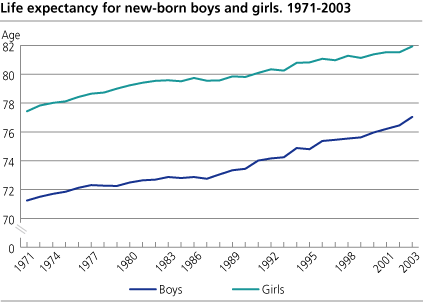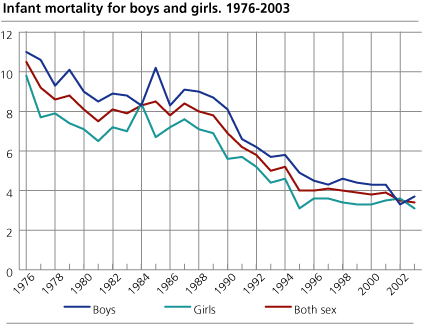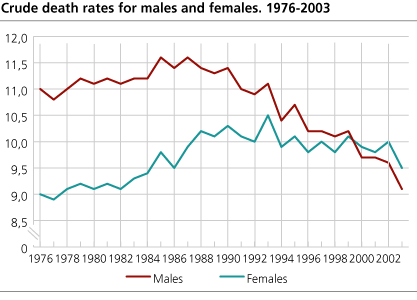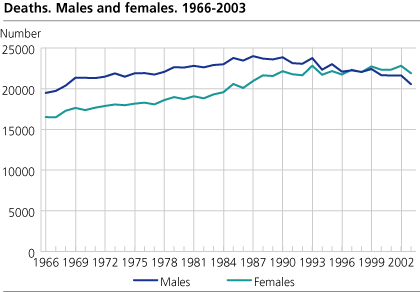Content
Published:
This is an archived release.
We live longer than ever before
In 2003 42 480 persons died in Norway - 2 000 fewer than in 2002. We need to go back to the mid 1980s to find corresponding low figures. At the same time life expectancy continued to increase for both sexes. Newborn boys my expect to live until they are about 77 years old and newborn girls almost 82 years - the highest figures ever for Norway.
From 2002 until 2003 life expectancy increased by 0.59 years for newborn boys and 0.41 years for newborn girls, and reached 77.04 years for men and 81.93 years for women. This is one of the highest increases in life expectancy for the past fifty years.
For the fifth year in a row, life expectancy increased more for men than for women. We have to go back to the 1950s to find a smaller difference.
Figures from 2002 show that in the Nordic countries, Icelandic and Swedish men live longer than the Norwegians with respectively 78.4 and 78.0 years. Otherwise in Europe only men from Austria, Switzerland and Italy may expect to live longer than the Norwegians. It is still the Japanese men that live longest in the world, but now Icelandic men are at the same level, with 78.4 years. Among the Nordic women, Swedish and Icelandic may expect to live longer than the Norwegian ones. European women that live longer than the Norwegians are the French, Swiss, Spanish, Swedish, Italian, Austrian and Icelandic. Japanese women live longest in the world with 85.3 years. In this comparison countries with less than 100 000 inhabitants are excluded.
Still decline in infant mortality
In 2002 infant mortality, which is deaths under one year of age per 1 000 live births, was the lowest ever registered in Norway. In 2003 infant mortality decreased even more, and came down to 3.37. Infant mortality for boys increased a little compared to 2002 and came to 3.65, something that is probably a chance. Despite the small increase it is much lower than for all other years. Infant mortality for girls came to 3.06 - the lowest ever. There has been a clear increase in life expectancy for men despite that infant mortality increased slightly from 2002 until 2003.
In the years 1999-2003, infant mortality was highest in Aust-Agder, with 5.2, and lowest in Nord-Trøndelag, with 2.5. The country's average was in the same time period 3.7.
Figures from 2002 show that infant mortality in the Nordic countries is low compared with the rest of Europe. Among the Nordic countries only Denmark has higher infant mortality than Norway. Iceland had the lowest infant mortality in Europe by 2.2.
Most women died
Of the 42 480 people who died in 2003, 22 800 were women and 21 640 men, 1 350 more women than men. Since 1999 there have been, as opposite to the years before, more women than men who died. This is mainly due to changes in the population's age composition.
The crude death rate, deaths per 1000, decreased a lot from 2002 until 2003, from 9.8 to 9.5, and is the lowest back to 1976. The death rates were 9.1 for men and 9.5 for women.
55 per cent of the dead were 80 years and above
55 per cent of those who died in 2003 were 80 years and older, almost as the previous year. 65 per cent of the women died in this age group, while the figure for men was 45 per cent. The proportion of persons older than 80 years at the time of death was highest in Sogn og Fjorande with almost 62 per cent, and lowest in Finmark with 42. This is because there are more old people in Sogn og Fjordane than in Finmark.
Tables:
- Table 1 Deaths and death rates. 1961-2003
- Table 2 Death males and females, by age and county. 2003
- Table 3 Death males by age and county. 2003
- Table 4 Death females, by age and county. 2003
- Table 5 Deaths per 1 000 population. Standardized rates. County. 1949-1985
- Table 6 Age-specific death rates for males and females. 1971-2003
- Table 7 Expectation of life for males and females at selected ages. 1946-2003
- Table 8 Perinatal and infant mortality. 1956-2003
- Table 9 Infant mortality, by county. 1966-2003
- Table 10 Life tables , 2003
- Table 11 Expectation of life for males and females at selected ages, by county. 1971-2000
Contact
-
Anders Sønstebø
E-mail: anders.sonstebo@ssb.no
tel.: (+47) 46 66 37 74
-
Magnus Haug
E-mail: magnus.haug@ssb.no
tel.: (+47) 40 81 14 91
-
Ane Margrete Tømmerås
E-mail: ane.tommeras@ssb.no
tel.: (+47) 91 99 29 62
-
Statistics Norway's Information Centre
E-mail: informasjon@ssb.no
tel.: (+47) 21 09 46 42
-
Oppdrag befolkningsstatistikk
E-mail: befolkning@ssb.no




